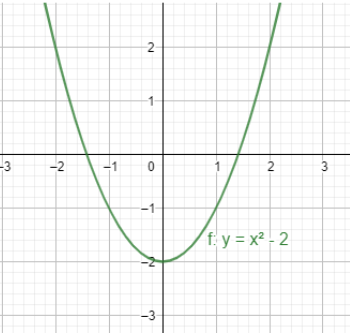
How do you find the inverse of $f\left( x \right)={{x}^{2}}-2$ from $x\le 0$ and graph both $f$ and ${{f}^{-1}}$?
Answer
510.3k+ views
Hint: We first explain the expression of the function as we take $y=f\left( x \right)={{x}^{2}}-2$. We convert the function from $y$ of $x$ to $x$ of $y$. The inverse function on being conjugated gives the value of $x$. At the end we interchange the terms to make it a general equation.
Complete step-by-step solution:
We need to find the inverse of the equation of ${{x}^{2}}-2$.
The given equation is a function of $x$ where we can write $y=f\left( x \right)={{x}^{2}}-2$.
If we take the inverse of the equation, we will get $x={{f}^{-1}}\left( y \right)$.
The given function was of $x$. We convert it to a function of $y$ and that becomes the inverse of $y={{x}^{2}}-2$.
We need to express the value of $x$ with respect to $y$.
We first add 2 on both sides of the equation and get
\[\begin{align}
& y={{x}^{2}}-2 \\
& \Rightarrow y+2={{x}^{2}} \\
\end{align}\]
Now we take square root on both sides and get
\[\begin{align}
& {{x}^{2}}=y+2 \\
& \Rightarrow x=\pm \sqrt{y+2} \\
\end{align}\]
Therefore, the expression of $x$ with respect to $y$ is \[x=\pm \sqrt{y+2}\].
Now as we know any general expression of any function is defined by the function of $x$.
We try to interchange the position of $x$ and $y$ in the equation \[x=\pm \sqrt{y+2}\] to form the inverse equation in general form.
From \[x=\pm \sqrt{y+2}\], we get \[y=\pm \sqrt{x+2}\]. So, $y={{f}^{-1}}\left( x \right)=\pm \sqrt{x+2}$
Therefore, the inverse function of $f\left( x \right)={{x}^{2}}-2$ is \[y=\pm \sqrt{x+2}\].
The range of the function $f\left( x \right)={{x}^{2}}-2$ is equal to the domain for the ${{f}^{-1}}\left( x \right)=\pm \sqrt{x+2}$ and it is $\left[ -2,\infty \right)$.
The graphs for $f\left( x \right)={{x}^{2}}-2$ is

The graphs for ${{f}^{-1}}\left( x \right)=\pm \sqrt{x+2}$ is

Note: All quadratic equations cannot have an inverse. It’s necessary to understand the concept of domain as the inverse function has to be well-defined. For our inverse function of ${{f}^{-1}}\left( x \right)=\pm \sqrt{x+2}$, the restriction is $x\ge -2$. Otherwise, the function becomes imaginary.
Complete step-by-step solution:
We need to find the inverse of the equation of ${{x}^{2}}-2$.
The given equation is a function of $x$ where we can write $y=f\left( x \right)={{x}^{2}}-2$.
If we take the inverse of the equation, we will get $x={{f}^{-1}}\left( y \right)$.
The given function was of $x$. We convert it to a function of $y$ and that becomes the inverse of $y={{x}^{2}}-2$.
We need to express the value of $x$ with respect to $y$.
We first add 2 on both sides of the equation and get
\[\begin{align}
& y={{x}^{2}}-2 \\
& \Rightarrow y+2={{x}^{2}} \\
\end{align}\]
Now we take square root on both sides and get
\[\begin{align}
& {{x}^{2}}=y+2 \\
& \Rightarrow x=\pm \sqrt{y+2} \\
\end{align}\]
Therefore, the expression of $x$ with respect to $y$ is \[x=\pm \sqrt{y+2}\].
Now as we know any general expression of any function is defined by the function of $x$.
We try to interchange the position of $x$ and $y$ in the equation \[x=\pm \sqrt{y+2}\] to form the inverse equation in general form.
From \[x=\pm \sqrt{y+2}\], we get \[y=\pm \sqrt{x+2}\]. So, $y={{f}^{-1}}\left( x \right)=\pm \sqrt{x+2}$
Therefore, the inverse function of $f\left( x \right)={{x}^{2}}-2$ is \[y=\pm \sqrt{x+2}\].
The range of the function $f\left( x \right)={{x}^{2}}-2$ is equal to the domain for the ${{f}^{-1}}\left( x \right)=\pm \sqrt{x+2}$ and it is $\left[ -2,\infty \right)$.
The graphs for $f\left( x \right)={{x}^{2}}-2$ is

The graphs for ${{f}^{-1}}\left( x \right)=\pm \sqrt{x+2}$ is

Note: All quadratic equations cannot have an inverse. It’s necessary to understand the concept of domain as the inverse function has to be well-defined. For our inverse function of ${{f}^{-1}}\left( x \right)=\pm \sqrt{x+2}$, the restriction is $x\ge -2$. Otherwise, the function becomes imaginary.
Recently Updated Pages
Master Class 12 Economics: Engaging Questions & Answers for Success

Master Class 12 Maths: Engaging Questions & Answers for Success

Master Class 12 Biology: Engaging Questions & Answers for Success

Master Class 12 Physics: Engaging Questions & Answers for Success

Master Class 8 Maths: Engaging Questions & Answers for Success

Class 8 Question and Answer - Your Ultimate Solutions Guide

Trending doubts
Which animal has three hearts class 11 biology CBSE

1 Quintal is equal to a 110 kg b 10 kg c 100kg d 1000 class 11 physics CBSE

Explain zero factorial class 11 maths CBSE

Mention the basic forces in nature class 11 physics CBSE

What is centripetal acceleration Derive the expression class 11 physics CBSE

Bond order ofO2 O2+ O2 and O22 is in order A O2 langle class 11 chemistry CBSE




